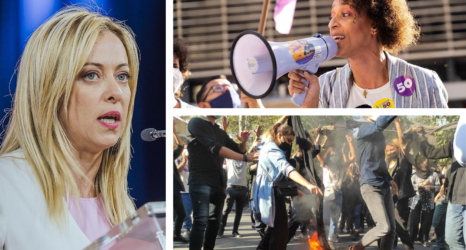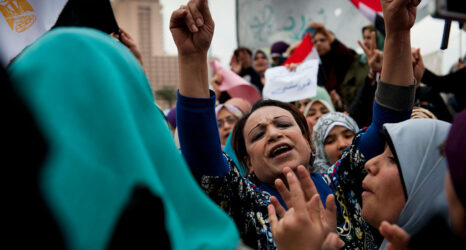On Sunday, May 6, Tunisia held its first ever municipal elections, a first among its North African neighbors. These elections mark yet another milestone in Tunisia’s transition to multi-party democracy. Beginning with its popular revolution in early January 2011, Tunisia’s transition has made a number of accomplishments—amongst them, a notably inclusive constitution-reform process that took place from 2011 to 2014.
Constitution-reform processes provide states and citizens a rare opportunity to define a new vision for a country. They can chart a route out of conflict toward a more equitable and just society. But this bright horizon is too often unrealized, hampered by the fact that women make up only 19 percent of constituent assemblies in countries experiencing unrest.
After its 2011 revolution, Tunisia broke this mold by electing women into 31 percent of the seats in its constitution-making body, with many more influencing the process from outside its halls. A new report by Inclusive Security illustrates how women shaped Tunisia’s constitution into arguably the most progressive of the Arab world and offers three lessons for women in Syria and other states likely to undergo constitution reform.
Lesson 1: Mobilize Early
Constitution reform has long been thought of as a standalone process, but women’s early mobilization can have positive impacts on women’s inclusion and the inclusion of their priorities. In Tunisia, political bargaining and mobilization began well before members of the National Constituent Assembly were elected. Women during this period zeroed in on two key issues: who would ultimately draft the constitution and what issues they would prioritize.
To ensure women would be represented in the assembly itself, women in the Higher Authority for the Realization of the Objectives of the Revolution, Political Reform, and Democratic Transition advocated for an electoral law to promote their inclusion. They succeeded in establishing a “vertical zipper” which required parties to alternate between male and female candidates in their electoral lists, preventing them from stacking the top of their lists with men and relegating women to lower positions.
Meanwhile, at the grassroots level, sixteen women’s organizations formed a coalition to inform the constitutional debate with early commentary on issues affecting women. Others like Aswat Nissa launched campaigns to encourage women to take part in October 2011 elections for the constituent assembly.
These and many other parallel efforts helped elect 67 female members (31 percent) to Tunisia’s constituent assembly, well above the global and regional average.
Lesson 2: Act on Shared Interests
The essentialist assumption that women will agree on certain issues simply because they’re women overlooks the intersectional nature of women’s identities. After the revolution, Tunisians were deeply divided on a number of issues far more complex than the “Islamist vs. secular” narrative portrayed by many. Men and women alike were polarized, posing a significant barrier to cross-partisan cooperation within the constituent assembly. But women from across the political spectrum discovered they agreed on principles like gender equality and women’s political representation. Recognizing these shared interests, they reached across party lines to develop solutions independent from their political party agendas.
The process was contentious and difficult. Although some women never accepted the negotiated outcomes, this strategy facilitated the passage of constitutional articles on gender equality and parity.
Lesson 3: Leverage Formal and Informal Participation
Obtaining 31 percent of seats in the constituent assembly was a vital accomplishment for Tunisian women—but the constituent assembly did not operate in a political vacuum. Given the nature of the revolution and the political transition overall, the events happening outside the assembly inevitably influenced the actions inside.
Women legal experts influenced the constitutional process by providing advice and testimony to constituent assembly members—many of whom, as first time elected representatives, had little familiarity with the legislative process. They ensured language on equal rights and opportunities left little room for interpretation by judges.
Women in civil society also linked the national-level process to populations outside the capital city. Al Bawsala made the initially insular drafting process more accessible and transparent by broadcasting assembly proceedings via social media. Almraa al-Horra, a women’s organization in Sfax, adapted the debate to their local context, hosting dialogues with Tunisia’s labor unions and local government officials to increase the presence of women in local industry and secure their rights to strike, health and security at work.
But by far the most recognized contributions of women’s organizations outside the constituent assembly were their demonstrations and protests, particularly regarding the debate over “complementarity.” The first draft of the constitution included a clause that many Tunisians interpreted to mean women were “complementary,” rather than equal, to men. While supporters of the clause insisted the Arabic draft had been mistranslated and inaccurately reported by the media, thousands of women took to the streets—and the second draft of the constitution abandoned the concept of complementarity altogether.
Tunisian women’s focus on the steady, systematic accumulation of their constitutional rights and freedoms produced a legal bedrock for future advances. Of course, they faced innumerable difficulties—including challenges to their political legitimacy and competency, disproportionate physical and reputational attacks and long hours in the constituent assembly that forced them to juggle their responsibilities as political actors, mothers and caregivers. But thanks to their persistence and political savvy, Tunisia’s constitution now enshrines an Islamic country operating as a civil state—supporting moderation, tolerance and human rights; and protecting the equal rights and duties of women and men.
The strategic foresight and tenacity brought by Tunisian women across the political spectrum illustrates the lasting impact that women can have on constitution reform, and how constitutions can enshrine women’s rights and representation.
To be sure, constitutions are only the first step; the power of these documents lie in their implementation. But Tunisian women now have a legal framework to hold the state accountable. May these hard-won victories serve as lessons for women in Syria and elsewhere seeking to influence constitutional processes in their own countries.





